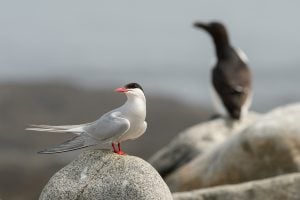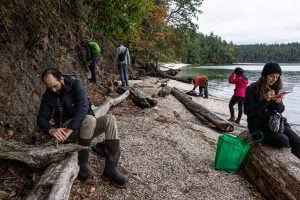
Wildlife
Should we kill one bird to save another?
On New Brunswick’s Machias Seal Island, predatory gulls are pushing endangered Arctic tern colonies to the brink, creating a dilemma for wildlife managers
- 2151 words
- 9 minutes
Travel
Why February on Hilton Head Island is for lovers — of natural history and cultural heritage

A barrier island on the South Carolina coast, Hilton Head Island acts as a natural breakwater, buffering the mainland from Atlantic Ocean storms. For many people who flock here each year, the island also serves as a temporary respite from the long, dark winters to the north. The Westin Hilton Head, in this context, is a cocoon, a village complete with four restaurants, three pools, an event space for live concerts and other cultural acts, children’s play areas and direct access to the Atlantic swell for dipping your toes or going full-out with a swim.
Being a vacation spot that draws more than two million visitors a year, Hilton Head can seem congested with human interference, both in terms of the influx of people and the built environment. Despite that, the great outdoors may well be the island’s most alluring feature, and the Westin makes it easy to commune with nature. Saw palmettos shade the premises while doubling at certain times of the day as the perfect hide-out for birds and at other times as their performance stages. Just beyond the hotel’s gates, the wide sand beach creates a kilometres-long promenade ideal for sunrise runs or walks, the occasional (if you’re lucky) dolphin sighting, and afternoon pick-up Frisbee games (as long as the wind collaborates). Plus, in winter when beach crowds are sparse, physical distancing is a snap. For an eco-friendly way to explore the island, the hotel has bikes for rent. At roughly seven kilometres wide by 18 kilometres long, Hilton Head is small enough to pedal around in a day; some 100 kilometres of bike paths wend beneath southern live oaks draped with Spanish moss and past saltmarshes studded with oyster beds. For a deeper immersion in the natural world, book a room on the ocean side and leave the balcony door open a notch at night, to let the sound of the waves and the sway of the palmettos lull you to sleep.
The Westin Hilton Head also gives guests a reality check by presenting a glimpse into the region’s violent past via a permanent exhibit about the enslavement of people stolen from West Africa. Hilton Head Island and the other Sea Islands along South Carolina and Georgia were before the Civil War a sort of epicentre of the slave trade, slavery and forced labour on plantations growing cotton, rice and indigo. The hotel’s second-floor showcase offers an overview of the events that led to the first Sea Islands slaves being freed in 1862 and the establishment in the same year of Mitchelville, the first self-governing Freedmen’s village in the U.S. The site of Mitchelville is located less than a kilometre north of the hotel premises — history is a short walk away from your hotel room.

Outside Hilton Head takes guests boating, kayaking or stand-up paddleboarding for a close-up of the particular aquatic ecology surrounding the island. Saltwater marshes are a dominant feature in this part of the Lowcountry, and it’s not uncommon to see bottlenose dolphins crisscrossing the channels as they hunt for fish. Along the shoreline, you will likely spot the American oyster catcher foraging on the rough oyster beds laid bare at low tide. The longer your outing (tours range from one and a half hour to a full day), the better your chances of wildlife encounters, and the more time for your guide to get into details of flora and fauna and of human settlement in the area. You can also rent a kayak or SUP and go out on your excursion.
The Gullah Museum of Hilton Head Island has as its mandate to preserve Gullah culture for future generations. To do so, it builds on knowledge passed down from previous generations, going back to the West Africans who were forced into the cargo holds of ships and taken across the Atlantic Ocean to serve as slaves in America. Despite their treatment, the Gullah, or Geechee, have managed to preserve much of their heritage, including artistic expressions, songs, stories, and culinary traditions. (Check the website or call ahead to make sure the museum is open; it has been closed due to the COVID-19 pandemic.)
The Coastal Discovery Museum gathers cultural heritage and natural history under one roof — and outdoors, via educational boardwalks and guided tours on land and on the water. After exploring the African origins of American art, such as sweetgrass basket weaving, visitors can stroll through the onsite gardens, including one showcasing camellias and another on carnivorous bog plants. For the wildlife aficionado, the museum features exhibits on local fauna, including turtles and alligators. Tuesday visitors can check out the Hilton Head Farmer’s Market, on the museum grounds, from 9 a.m. to 1 p.m.

Arc’teryx’s Trino SL hoody (full zip for him, anorak-style for her) may have been conceived for workouts in cool mountain environments, but the lightweight garment also works wonders on early morning runs along the beach on Hilton Head Island. Made from Gore-tex Infinium, the softshell is made to block even the hardest of winds, like those that might blow in from the Atlantic Ocean in winter. And no worries if it’s foggy or drizzly, the breathable Trino is also water resistant (but not waterproof).
Osprey has updated one of its best-selling backpacks — the Talon (for him) and Tempest (for her) — with a lighter-weight yet more durable fabric. The brand-new Tempest Pro and Talon Pro also come with a clip for bike helmets (handy when stopping for lunch on a cross-island pedal mission). Favourite features like the external hydration sleeve and the snap-closure mesh pockets on the shoulder straps (great for keeping a phone in easy reach) have been kept in the Pro versions.
Earthwell makes lightweight stainless steel bottles that encourage refilling rather than buying water and other drinks in single-use plastic containers. The Kewler Opener Bottles, which hold roughly one or two litres, are insulated, keeping iced drinks icy for up to 72 hours, cold drinks cold for up to 32, and hot drinks hot for up to 20. The cap has a built-in bottle opener for popping a beer or two and pouring into the Kewler for a cold one on the go.
Are you passionate about Canadian geography?
You can support Canadian Geographic in 3 ways:

Wildlife
On New Brunswick’s Machias Seal Island, predatory gulls are pushing endangered Arctic tern colonies to the brink, creating a dilemma for wildlife managers

People & Culture
Naming leads to knowing, which leads to understanding. Residents of a small British Columbia island take to the forests and beaches to connect with their nonhuman neighbours

Mapping
Canadian Geographic's cartographer Chris Brackley shares insights into his process in charting the country's largest islands for an exclusive wall map

Wildlife
Our love of deer runs deep. But as their numbers surge and damage mounts, it may be time for a reckoning.